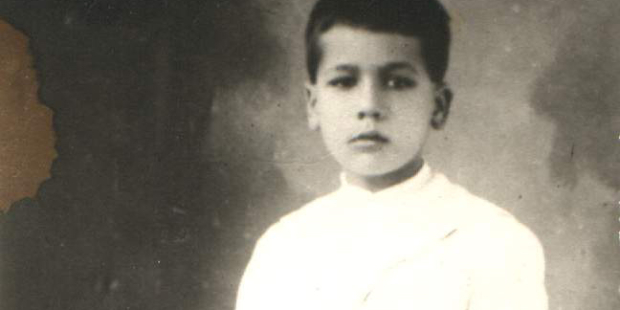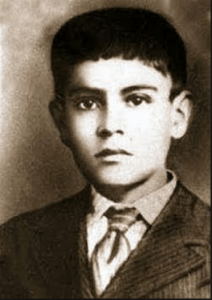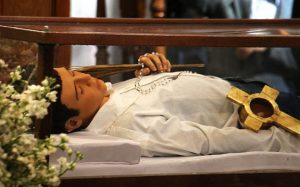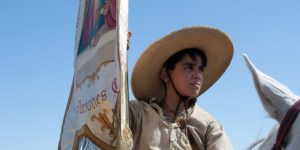
St. José Sánchez del Río was a defender of the Faith during the anti-Catholic Calles regime in 20th century Mexico. José was born in 1913 to Macario Sánchez Sánchez and his wife Maria del Río Arteaga. The family lived at Sahuayo in the Mexican state of Michoacán. José was a devout child, especially devoted to Our Lady of Guadalupe. He was active in parish life and the family prayed a rosary together each day. He went to school in his hometown.

PERSECUTION OF THE CHURCH UNFOLDS
During José’s childhood, a dark cloud of Church persecution gathered in Mexico. A new socialist constitution was written in 1917, mandating a number of anti-Catholic laws. The number of priests allowed and the availability of the Sacraments were limited and preaching was monitored. When Plutarco Calles became president in 1924, he aggressively enforced these laws. In addition, he banned Catholic education, priestly ordinations, religious vows, the wearing of religious or clergy garb, and worst of all, public Masses. Church property was confiscated, and convents and monasteries were disbanded. Priests who violated these new laws were jailed and often put to death. In defense of the right to religious liberty, faithful people, especially in the western and central Mexican states, formed an armed rebellion against the government. This set off what was known as the Cristero War, beginning in 1926. Their ever-present war cry was “Viva Cristo Rey!”, or Long Live Christ the King!
A YOUNG CRISTERO SOLDIER
José was well aware of this national tragedy, and when his two brothers joined the Cristero forces in 1926, he wanted to join. Neither his parents, nor the rebel officers would allow him to join the forces because he was barely thirteen years old. However, José did not give up his efforts to join, knowing quite well that doing so could cost him his life. In fact, he greatly desired to give his life for the cause of Christ and His Church. Finally, after meeting together with a Cristero officer, Macario and Maria allowed him to go in order to be a flag bearer. He left home with a companion and they joined the closest troop of rebel militia. The boys were given simple auxiliary tasks such as caring for the horses, cleaning firearms, and water and food service. José also proudly carried the banner for the Cristero forces. He was well liked by the troops and together they had a daily Mass and recitation of the Rosary. José was placed under the protection of General Luis Guizar Morfin.
CAPTURED
During a battle in early 1928, while the defeated federal forces were retreating, they suddenly turned and opened fire, killing the general’s horse out from under him. Knowing that the presence of the general was essential, José gave the general his own horse. The general told him to flee, but he insisted, shouting “Viva Cristo Rey”, abandoning his horse and running for cover. After firing at the enemy until he ran out of bullets, he was captured by the federal troops.
Beaten and mocked by the soldiers, José was taken to a prison cell, where he wrote a letter to his mother, and then to the church where he had been baptized in Sahuayo.
UNWILLING TO RENOUNCE HIS FAITH
The federal troops spared no effort to make José renounce his faith, forcing him to witness the hanging death of another prisoner and offering him admittance to a prominent military academy if he would curse Christ. All efforts were fruitless. The federal troops continually desecrated the church where they held José. Animals were housed there, food scraps and beer bottles were strewn about, and the altar had been used for firewood. Fighting gamecocks roamed about freely, including on the tabernacle. Unable to bear this sacrilege any more, one evening José broke the necks of the roosters one by one. Infuriated by the destruction of such “valuable” animals, the federal authority ordered José’s death. Perversely, the man who ordered the killing was José’s own godfather. José was able to receive Holy Communion one last time, smuggled in by his aunt. In one last effort to break his resolve, the soldiers cut into the soles of his feet. He was then forced to walk barefoot through the town to the cemetery. He prayed a rosary aloud through this sad spectacle and a trail of blood followed him from his foot wounds. At the cemetery, he was repeatedly stabbed, crying out “Viva Cristo Rey!” with each strike. Finally, they shot him and threw him into a grave. It was February 10, 1928, just weeks short of his fifteenth birthday. When the troops had cleared away, José’s priest uncle retrieved the body, so that proper prayers could be offered.

NOW ENSHRINED
José’s remains were eventually taken to a shrine for Cristero martyrs, and in 1996, transferred to the Sahuayo church where he was baptized and held captive.
Word of the martyrdom of the young Cristero spread quickly, and his life of faith and courage was a model for the Mexican people. Young José faced his death willingly, his only concern was the grief it would cause his family.

His life was admirably portrayed in the 2012 film For Greater Glory, in which he was played by Mexican actor Mauricio Kuri. St. José Sanchez del Rio is especially remembered on his February 10 feast day.
